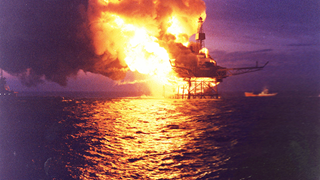
On July 6, 1988, the world’s worst oil disaster struck the Piper Alpha oil platform in the North Sea, 120 miles (190 km) off the Scottish coast. Two massive explosions engulfed the platform in a fireball, killing 167 men. After the 63 survivors had been rescued, the problem was to extinguish five blazing wells.
The twisted platform was covered with slippery oil and smouldering wreckage, some pieces weighing more than 20 tons. Before any of the fires could be put out, the debris had to be cleared. But the platform’s temperature had reached well over 1000 and it was tilting at 45 degrees. It was in danger of collapsing completely and the burning wells could have exploded.
Red Adair flew in from America. Fortunately, Tharos – a 30,000 ton emergency vessel, was near the platform, packed with fire-fighting equipment. Designed by Adair, it had a 135-man crew, three cranes, a diving bell and a decompression chamber, a ‘fire-boom’ and 16 water cannons.
Some of the water cannons were used to throw up a blanket of water to protect Tharos from the intense heat as it came within 85ft (26m) of the platform. The rest were directed at the fires.
The fire-boom is a telescope mechanical arm that can move up and down, or from side to side. It can extend 62ft (19m) beyond the deck. The main crane lifted the debris from the platform.
While the deck was being cleared the cannons sprayed millions of gallons of sea water on the deck, and eventually the fires were extinguished. But oil was still pouring from the well heads over the platform.
Once the deck had cooled sufficiently, sea water was pumped into the wells under high pressure, stemming the flood of oil. As soon as the oil stopped flowing out, cement was pumped into each well to seal it permanently. Red Adair and his crew cleared all the debris and controlled the wells in just 36 days.
Every oil-well fire has its own particular problems, but the same basic methods are used to extinguish them. The simplest is to stop the flow of oil or gas by closing the pipeline valves. But after a blow-out these valves are often damaged, or impossible to reach because of the heat.
After an explosion on the Ekofisk platform in 1977, oil was pouring out of a well at great pressure and at temperatures of nearly 100 . The force of the escaping oil was too strong to be countered by pumping in sea water. Red Adair tried using hydraulic rams to push two semicircular discs together to shut off the top of the well head. But fitting the rams in such conditions was not easy. One spark and the oil would have ignited. After five attempts, more powerful hydraulic rams were used and succeeded.
Relief wells may be drilled to divert some of the oil from a ruptured pipe or well and reduce the pressure and volume.
In case the initial plan of using water and cement to control the Pipe Alpha blow-out had failed, the semi-submersible drilling rig Kingsnorth had already begun to drill another well to a depth of 8500ft (2600m) beneath the seabed. The idea was to seal the well with cement from the bottom and block the oil flow, but this was never necessary. The Red Adair team was able to cap all the wells.
Picture Credit : Google

